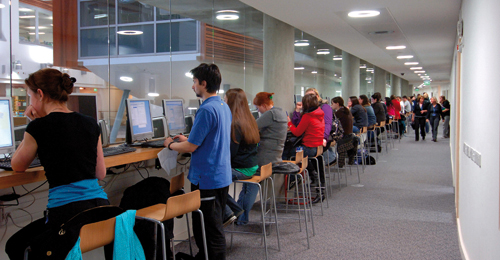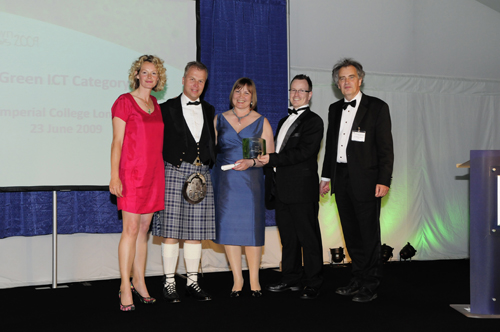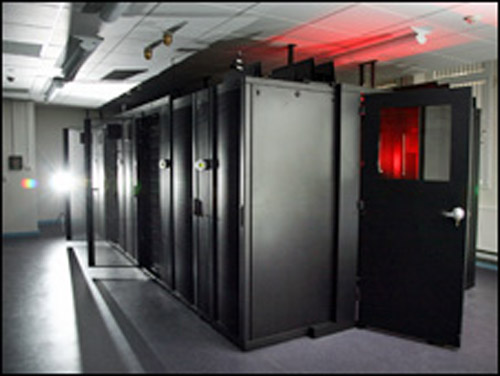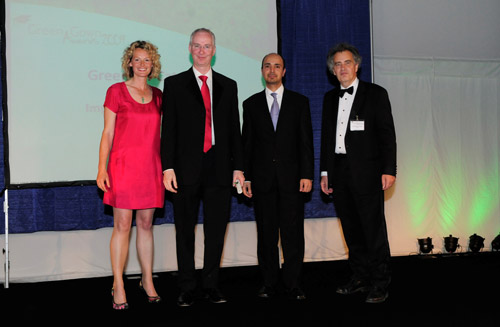Key Takeaways
- Higher education institutions in the U.K. recognize the need to reduce their carbon footprints and are implementing various measures towards that goal.
- JISC’s Greening ICT program aims to help universities and colleges in the U.K. address their technology carbon footprints.
- JISC sponsors the Green ICT category as part of the Green Gown Awards, recognizing environmental accomplishments by U.K. higher education.
With the world focusing on climate change and individuals through to organizations questioning how they can reduce their personal and professional carbon footprints, JISC (Joint Information Systems Committee) is looking at how it can help U.K. education professionals learn from one another. (See “What Is JISC?”) In 2009, the final report from JISC’s SusteIT study1 estimated that 623 U.K. colleges and universities will produce 500,000 metric tons of CO2, generated by one and a half million computers, 250,000 printers, and 240,000 services. The electricity used by these devices will cost over £100 million.
Through its Greening ICT program (for which I am the program manager), JISC addresses the need to help universities and colleges address their information and communication technology (ICT) carbon footprint. This article reviews the activity currently taking place in greening technology within higher education in the U.K. It also describes three case studies where universities have won awards2 in using green solutions to address technology challenges.
Listen to an April 2008 podcast about the need for the higher education sector to reduce its carbon impact, the SusteIT study, and the Greening ICT program.
Evaluating Green ICT in the U.K.
In 2008 JISC funded a major review, called the SusteIT Project, to look at the state of play of green ICT (see “What IS Green ICT?”) in the U.K. tertiary education sector. The final report for the study, published in January 2009, gave JISC and the institutions it serves valuable information about areas of good practice — and a look at the size and nature of the task ahead.
According to Peter James, director of the SusteIT project and professor of Environmental Management at the University of Bradford:
“There are a good number of UK institutions — in the double figures — that are taking sustainable ICT very seriously, while there is a second and significant group of organizations that are motivated and looking at cross-functional, strategic, and institution-wide links between ICT, estates, and other departments.”
James sees extensive institutional awareness of the importance of sustainability. Funding bodies are telling universities they have to act green, and students are saying the same thing. Caught in this pincer movement, higher education institutions really have to care about sustainability. James sees the cost issues as important, too, with IT being the lowest-hanging fruit with regard to sustainability and estimates that quick returns can be made in one to two years. Listen to his podcast explaining the SusteIT Project.
JISC will be funding more work in the green ICT area over the next few years. The Greening ICT program will provide direction, running projects to fill gaps in the knowledge base for this area and helping the sector grapple with procurement of less environmentally damaging equipment. JISC also sponsors the Green ICT category in the Green Gown Awards, which reward best practices in a range of environmental initiatives at universities and colleges. (See “The Green Gown Awards.”) The following case studies describe initiatives in three universities that won this award or were highly commended in 2009. Their initiatives demonstrate some of the excellent environmental progress in U.K. higher education institutions.
Thin Clients at Queen Margaret University
Queen Margaret University (QMU) is a small, specialized university in Edinburgh, Scotland. In 2007 the university moved into a brand-new campus on the outskirts of the Scottish capital. The aim of the design team (drawn from university staff and the architects) was to produce as sustainable a campus as possible. The achievement of this ambition was recognized by QMU’s receipt of the highest BREEAM rating. (BREEAM is an environmental assessment method for buildings around the world.)
The desire within the university was to provide access to computers throughout the main building, as well as to student residences and the students’ union. The problem that QMU faced in their design process was that using conventional PCs would have required the use of air-conditioning in areas of high computer density because of the heat they produce — a step the design team wanted to avoid. Thin clients presented as a solution because of:
- Lower power requirements (and therefore low heat production) of thin-client devices
- A shift of energy use and heat generation to the data center, where HP Blade servers plus a well-engineered power supply and well-designed cooling would handle the heat more efficiently
QMU chose thin-client devices from Wyse (V50L) along with TFT screens and Citrix to deliver the desktop experience. The university conducted a pilot implementation of the thin-client technology prior to moving to the new campus, which showed good acceptance of the approach and allowed university-wide rollout of the technology with the move. The university has around 1,200 thin-client terminals and about 30 PCs left for the work that thin-client technology doesn’t handle well (mostly 3D graphics and audio applications, along with some specialized software that uses specific hardware features). The desktop is available to mobile users through a Citrix client. Figure 1 shows QMU students using Wyse V50 thin-client terminals in the rapid-access area within the secure Learning Resource Centre on level 1 of the main academic building.

Figure 1. Thin-Client Technology at QMU
According to Fraser Muir, director of Information Services for QMU:
“Thin client is nothing new in itself. What we have done is taken thin client and the managed desktop that we provide through it and made them the key desktop computing provision within the university.”
The debate about thin-client technology versus thick-client technology continues, with many factors affecting estimates about the relative costs and benefits of each approach. The thin-client devices installed at QMU use 15 watts compared to the modern PCs typically used in universities, which use from 60 to 100 watts depending on the age of the PC. Add to that the load in the data center, which in QMU’s implementation comes to 7 watts per thin client. Both systems need file stores and network and domain controllers, but QMU made the case that they could have saved on support costs by reducing the support team by two staff. Instead, they chose to pursue the opportunity to take on additional services such as telephony and print without recruiting further staff. Most importantly, though, users have a more reliable experience with practically zero downtime because they can go to any other terminal if theirs fails. JISC has produced a comparison tool to help with detailed analysis of the factors involved in choosing thick versus thin clients.
Thin-client may not be the universal panacea that some claim, but it would seem to provide a good solution to reducing energy use and support costs in installations such as that at QMU, where the thin-client devices deliver the virtual desktop. Adding in the reduction in support costs that can come with thin-client technology, it becomes an option worth looking at.
QMU provides an interesting example of the benefits of embracing a particular technological opportunity whole-heartedly. This commitment won the university the top award in the Green ICT category of the Green Gown Awards, as shown in Figure 2.

Figure 2. QMU Receives the Green ICT Award June 23, 2009, at Imperial College London: (left to right) Kate Humble, BBC TV Presenter; Steve Scott, Director Estates and Facilities, Rosalyn Marshall, Vice Principal and University Secretary, and Fraser Muir, Director of Information Services and Learning Resource Centre, Queen Margaret University; Malcolm Read, JISC Executive Secretary
Further information about the building project and images of the new campus can be found on the QMU website, and a longer version of this case study is available online. In addition, a video of the QMU project is available on YouTube:
Film created by Jon Mowat and Michelle Pauli. © 2009 HEFCE. This film is licensed under the Creative Commons Attribution-Noncommercial-No Derivative Works 2.0 UK: England & Wales license.
Listen to the January 2009 podcast with Ann Thunhurst, Manager, JISC Regional Support Centre South East, on the “New Build — Zeroing on Carbon Footprints” event, which provided ideas and advice on creating carbon-zero buildings for colleges and universities. A report on the event is available in the Spring 2009 edition of the “RSC Newsletter”; presentations and other materials are available on the RSC South East New Build web page.
Green Supercomputer at Cardiff
Cardiff University is one of the U.K.’s top universities, with major research groups in many disciplines and was in major need of updating its’ supercomputing facilities. After obtaining funding, the university had to decide where to locate a new research computing facility on its city center campus. This building project was the stimulus for a thorough reappraisal of data center design within the university. The resulting data center provides a benchmark in efficiency and houses the university’s high-performance computer (HPC) and some of its enterprise systems.
Key to Cardiff’s achievement is the project’s attention to all parts of the facility’s design and implementation, as well as linking the planning, procurement, and installation processes for the computers and the cooling infrastructure. The computing contract for the HPC went to Bull, which provided 256 servers for the main cluster. Each cluster server had two quad-core processors and two gigabytes of RAM per core; they were housed in six racks. Extra racks for HPC purposes contain 100 terabytes of storage along with a number of other servers for user access and cluster management. Due to the high-density solution proposed for the HPC cluster and the resultant space saving, it became possible to house a significant additional enterprise computing facility there. The cooling system uses a contained hot-aisle setup with water-cooled chillers that, through use of variable speed fans, deliver even cooling to the racks. Moreover, the facility can use free cooling, at least in part, for more than half the year. Efficient modular UPS units alone will save an estimated £20,000 a year over more standard installations, as will the 80 watt quad-core Intel chips in the servers. The facility also uses an efficient transformer. This low-loss, high-voltage 600 kVA transformer cost 10 percent more than a standard system, but returned that investment in only one month, according to the university. Cardiff specified full power metering at every step, to allow accurate monitoring of energy use in the facility. The whole installation is managed through a web interface that controls fans, pumps, the UPS, power supply units, and closed circuit TV. Figure 3 shows the machine room in Cardiff’s new data center.

Figure 3. Cardiff University’s Machine Room, in the New Data Center
The original computer cluster planned for the data center took a fraction of the total space allotted, allowing the university to install a disaster tolerance site in the same space and still have room for other equipment. The design and build phase made provision for spare capacity in cooling pipes and the like to allow expansion of the data center as requirements grow. The additional capital costs of the project incurred by installing a more expensive cooling technology are estimated to be recovered in two to three years, while the life cycle of the equipment is eight to ten years.
Hugh Beedie, chief technology officer at Cardiff University, commented:
“It was the convergence of a number of factors that made this possible. These included the advent of quad core processors, high-density cooling, and the need to put the new facility in a new location within the university. The more I looked at how to do this, the clearer it became that the key was in the high-density architecture and the containment of hot air.”
Beedie has some lessons learned from the experience:
“I would be much more specific about the metering arrangements and would build the desired outcome in terms of the data center PUE [power usage effectiveness] into a tender in future. I’d also have the vendors supply some sort of meter that would display the real time PUE to help us keep an eye on what we are doing.”
Cardiff has shown the way on data centers for the U.K. education sector and deservedly was highly commended in the Green ICT category of the 2009 Green Gown Awards. The project’s attention to detail and the end-to-end engineering approach made the gains in environmental and cost terms really stack up. The university’s project combined with other JISC-funded work on data centers will help universities reduce this major cause of greenhouse gas emissions.
Listen to the August 2008 podcast with Hugh Beedie of Cardiff University, about a JISC workshop on environmentally sustainable IT at which he presented the plenary address on Cardiff’s new data center. Beedie estimates considerable savings and a solid return on the university’s investment.
A longer version of this case study can be found online.
Innovation in Procurement at Imperial College
Imperial College is a leading higher education institution for science, technology, medicine and business. The college, which spends over £270 million a year on goods and services, saw the opportunity to make improvements in its procurement practices that would deliver benefits in both environmental and efficiency terms. The aims of the project were to:
- Reduce the number of paper documents in use
- Increase business efficiency
- Cut paper and power consumption
- Reduce the amount of transportation associated with procurement
The college leveraged its existing Oracle e-Business Suite and, working with major companies in its supplier base, moved to a situation where 100 percent of purchase orders are sent to suppliers electronically. Half of the purchase orders are transmitted via XML, which is processed by the suppliers’ enterprise resource planning (ERP) systems.
Similar gains have been achieved across the remainder of the procurement and purchasing chains, with internal approvals routed electronically and a move to electronic catalogues that has reduced the number of printed catalogues needed. All purchasing and transaction information is stored electronically, freeing up archive space in department offices — a useful extra benefit in a crowded central London campus.
Benefits in environmental terms include a saving of 200,000 envelopes and more than two million paper documents in total. Organizational benefits have come from freeing up administrative time by streamlining the procurement process. Among the financial benefits are savings of over £40,000 in postal costs as well as savings in printing costs and staff time. Another benefit was a reduction of between 2 percent and 5 percent on suppliers’ prices by being able to trade electronically.
The approach at Imperial is unusual in the U.K. for the wholesale application of electronic methods to procurement and purchasing. The college made the point that the software systems that they use are commonly used in the U.K. tertiary education sector. In addition, their adoption of open standards means that the techniques and technology required to implement e-procurement are readily available to other institutions. Because the U.K. tertiary education sector has a well-developed procurement infrastructure, with regional consortia of institutions negotiating with suppliers, solutions similar to that adopted by Imperial College may well become more prevalent in the future. Imperial College’s e-procurement project was highly commended in the Green ICT category of the 2009 Green Gown Awards. Figure 4 shows Imperial College London staff receiving the highly commended for Green ICT Award.

Figure 4. Imperial College London are highly commended for the Green ICT Award June 23, 2009, at Imperial College London: (left to right) Kate Humble, BBC TV Presenter; John Whitlow, Head of Purchasing, and Amer Mahmood, ICT Project Manager, Imperial College London; Malcolm Read, JISC Executive Secretary
Conclusion
These examples along with other instances of good practice in the U.K. (some of which are available as case studies on the SusteIT project website) demonstrate progress in tackling the environmental impacts of ICT use. The thrust of JISC’s work over the next few years will be to:
- Ensure that these environmental best practices are widely disseminated
- Assist universities and colleges in adopting and using these ICT best practices effectively
- Help institutions comply with requirements to reduce carbon emissions in line with government and funding council demands.
To help address these goals, JISC has developed a tool to help institutions measure their carbon footprints (see “Measuring Your Carbon Footprint”). In addition, JISC will fund projects based in higher education institutions to grow the knowledge base around green ICT, develop exemplar and demonstrator projects, and strengthen the capacity of the sector to implement these changes.
Overall, green ICT or the environmental implications of ICT use and provision cannot be taken in isolation. Often efficiency gains in environmental terms go hand in hand with cost and wider efficiency savings, even if it is not always easy to connect capital and revenue budgets to enable these savings to be easily made. These case studies and the overview of other activity in the green ICT arena in the U.K. indicate that there is much that has been done — but there is more to do.
- “Sustainable ICT in Further and Higher Education: SusteIT Final Report,” JISC, January 13, 2009.
- The Green Gown Awards recognize the exceptional initiatives being undertaken by universities and colleges across the U.K. to become more sustainable. They are sponsored by the Environmental Association for Universities and Colleges (EAUC). JISC sponsored the Green ICT category of the Green Gown Awards in 2009.
© HEFCE 2009. The text of this article is licensed under the Creative Commons Attribution-Noncommercial-No Derivative Works 2.0 UK: England & Wales license.
